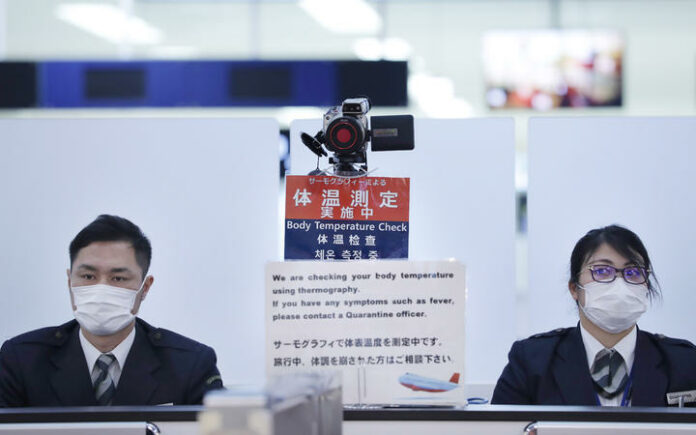Officers work at a health screening station as they observe passengers arriving on a flight from Wuhan, China, where a SARS-like virus was discovered, at Narita airport, Japan. Photo: STR / JIJI PRESS / AFP
Last year almost 51,000 tourists from China came to New Zealand in the month of the Chinese New Year, which coincides this weekend. But so far there are no plans to screen passengers arriving from China.
Analysis of the coronavirus strain, which has not previously been identified in humans, shows it is more closely related to Sars than any other human coronavirus. Sars also originated in China and killed 774 people in the early 2000s across several countries.
Six deaths have now been reported and more than 300 have been infected across major cities in China, including Beijing and Shanghai, according to Chinese health authorities. However most patients are in Wuhan, the central city of 11 million, where the disease was first identified late last year.
The outbreak is believed to be linked to a Wuhan seafood market that also sells live animals.
It’s been confirmed the virus can pass from person to person.
The World Health Organisation (WHO) will tonight be considering whether to declare an international public health emergency over the virus – as it did with swine flu and Ebola. Such a declaration, if made, will be seen as an urgent call for a co-ordinated international response.
New Zealand’s director of public health Caroline McElnay told Morning Report they were in talks with ESR (Institute of Environmental Science and Research) and labs to get the test up and running in New Zealand, but was unsure when that would happen.
“Australia has now been able to get that test up and running there, so at the moment we would have to send samples to Australia.”
New Zealand has followed a similar route to Australia by increasing the visibility of information via health advice cards, Dr McElnay said.
“We don’t have any direct flights in from Wuhan, it’s likely that some people could come in to New Zealand [from Wuhan] via Australia.
“We’re certainly not complacent about this, we have assessed that our risk is low and we’re certainly prepared to do what we need to do to ensure this virus doesn’t spread.”
Dr McElnay said there was also a policy in place that required airlines to contact public health units before landing if someone onboard was sick.
She said they were in close contact with WHO and keen to see the result of tonight’s meeting, with hopes for more specific information on the virus.
The virus causes a type of pneumonia and signs of infection include respiratory symptoms, fever, cough, shortness of breath and breathing difficulties.
WHO has advised people to avoid “unprotected” contact with live animals, thoroughly cook meat and eggs, and avoid close contact with anyone with cold or flu-like symptoms.
Screening of passengers and infected people overseas
In a national advisory to health professionals earlier this month, the Ministry of Health said it was also monitoring the situation but not recommending any specific measures for travellers beyond the regular advice given to people arriving in the country – urging them to seek medical advice if they get sick within a month of their arrival.
Authorities in Australia, Singapore, Hong Kong, Taiwan and Japan as well as San Francisco, Los Angeles and New York have stepped up screening of air passengers from Wuhan.
In Australia, a man who had travelled to Wuhan had been placed in isolation and underwent tests, but is no longer in quarantine. China is the largest source of tourists to Australia, with more than one million people visiting last year.
A handful of cases have also been identified abroad: two in Thailand, one in Japan, one in South Korea and one in Taiwan. Those infected had recently returned from Wuhan. A US spokesperson today said one traveller had been diagnosed in Seattle.
What is the situation now in China?
This mass movement of people could also mean that authorities will not be able to monitor further spread of the disease.
And experts say there already could be many cases going undetected.
A report by the MRC Centre for Global Infectious Disease Analysis at Imperial College London suggested there could be more than 1700 infections. However, Gabriel Leung, the dean of medicine at the University of Hong Kong, put the figure closer to 1300.
China’s National Health Commission on Monday confirmed for the first time that the infection could be transmitted from human-to-human. It said two people in Guangdong province had been infected in this way.
In a separate statement, the Wuhan Municipal Health Commission said at least 15 medical workers in Wuhan have also been infected with the virus, with one in a critical condition.
The workers presumably became infected with the virus due to contact with patients. All of them are being kept in isolation while being treated.
Source - rnz





























